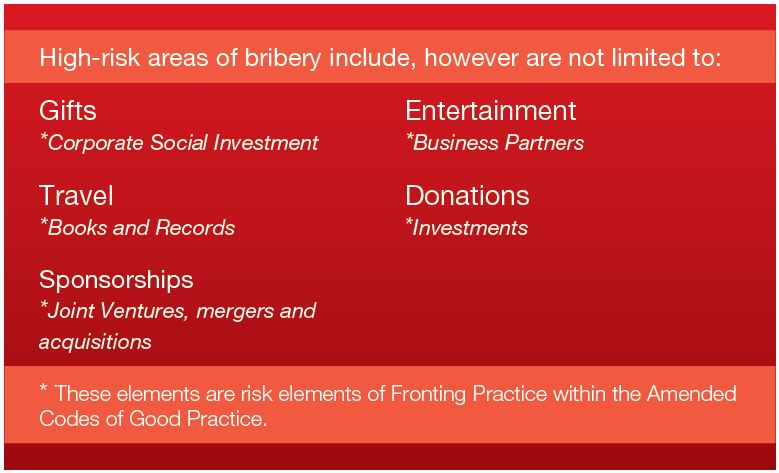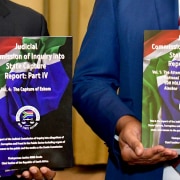|
Getting your Trinity Audio player ready...
|
By Steven Powell
Publisher’s note: “The publication of this article is not intended to highlight the harsh reality of bribery and corruption in our country. The core objective is to promote the need for organisations to implement remedial action, in order to curb bribery and corruption throughout all areas of their business.
“This article is based on the 2015 ENSafrica anti-bribery and corruption survey findings. The basis of the article is to define bribery and corruption, followed by an overview on the current situation in South Africa. It concludes with actual bribery statistics gathered from 88 organisations operating throughout Africa. These statistics give insight into risk areas, as well as appropriate remedial action.”
Is there value in integrity?
It has been said that bribery and corruption are victimless crimes. However, the millions of people in South Africa, and Africa alike, living below the breadline are the invisible victims of these crimes. The findings of the 2015 ENSafrica anti-bribery and corruption survey reveal that South Africa is one of the top eight corruption hot spots in Africa, alongside Angola, Democratic Republic of the Congo, Ghana, Kenya, Mozambique, Nigeria and Uganda.
According to Steven Powell, “Corruption impacts the poorest of the poor, stripping governments of their already limited resources and making it extremely difficult to provide effective services to the communities they serve. I feel strongly that the private sector has a significant role to play in addressing the scourge of corruption that is threatening to destroy South Africa. Regulation 43 of the Companies Act has introduced a range of measures that organisations need to implement in order to mitigate the corruption risk. However, we have found that most organisations in South Africa are not aware of what the law requires. They are, furthermore, not aware of the practical steps to take in order to manage corruption risks.
“For me, creating awareness regarding managing corruption risks is critical to any organisation’s growth and sustainability. Transparency International’s message is clear: understanding corruption is the first step in fighting corruption.”
In addressing bribery and corruption, which essentially go hand in hand, it is imperative that the definitions are clear.
bribery
noun | brib•ery
Bribery is defined as the offering, giving, receiving, or soliciting of any item of value, to influence the actions of an official or other person in charge of a public or legal duty.
corruption
noun | cor•rup•tion
Corruption is the abuse of entrusted power for private gain. It can be classified as grand, petty or political, depending on the amount of money lost and the sector where it occurs.
corrupt (to be)
adjective | cor•rupt
Either having or showing a willingness to act dishonestly in return for money or personal gain.
Not enough resources
South Africa has a strong legislative framework to address bribery and corruption. However, there is a shortfall within our infrastructure to adequately investigate, prosecute and hold those found guilty accountable for their offences. To date, there are limited examples of accountability, with the late former police commissioner, Jackie Selebi, being one of the few officials brought to book for corruption.
Over the past year, there have been many instances which have played out in the media that have been widely branded as corruption. The FIFA World Cup bribery scandal is one prime example. Another is irregular spending and awarding of tenders by local government officials as well as cases of maladministration by parastatals. However, although public procurement is more prone to corruption, the private sector has certainly not gone unscathed. The fact is, billions of rands from both the public and private sectors have benefited bribery and corruption thieves. Generally, when bribery and corruption come to the forefront, it is the one who pays the bribe or benefits from corruption who is publicly seen as accountable. However, equally accountable is the person tangibly benefiting from ill-gotten gains.
The results of the ENSafrica survey highlight that, although bribery and corruption have increased, so too has general awareness. This, specifically in the private sector, has brought about more stringent checks with policies and procedures in place to curb the practice. The magnitude of consequences for organisations caught up in bribery and corruption practices are far reaching, like blacklisting, penalties, reputational damage, criminal prosecution and, thereafter, stringent costly controls.
A total of 88 organisations across Africa participated in the survey. The core aim was to establish the amount of anti-bribery compliance within these organisations, as well as the level of bribery incidents these organisations had encountered. The survey was designed to gauge perceptions regarding an organisation’s anti-corruption compliance commitment in order to observe local and global requirements.
Of the 88 organisations surveyed, 24% had experienced incidents of bribery and/or corruption over the past 24 months. Five percent of these experienced five or more instances. Other key findings include:
- over 90% have a policy in place prohibiting bribes.
- 52% have an established anti-bribery compliance programme.
- 43% have conducted a detailed anti-bribery risk assessment of risk areas.
- 68% believe that third-party business partners pose the greatest source of bribery risk within their organisation.
- 17% feel they are highly exposed to bribery in Africa – a subsequent drop of 33% compared to 2013. This decrease may be attributed to organisations embracing the challenges of anti-bribery compliance, by implementing workable compliance programmes that mitigate bribery risks.
- 71% believe they are moderately exposed to bribery and corruption in Africa.
- Only 36% are confident they have proportionate procedures in place to mitigate bribery risks; or believe they are sufficiently prepared to respond to the threat of an anti-bribery regulatory investigation.
- 62% conduct due diligence screening on third parties, an increase of 22% from 2013.
- 40% have a dedicated anti-bribery training programme in place addressing this issue with their workforce.
- 15% provide anti-bribery training to their business partners.
Findings indicate that organisations which act proactively to address bribery have fewer incidents than those overlooking the issue. Such proactive interventions include:
- An anti-bribery compliance programme;
- A dedicated anti-bribery policy;
- Top-level commitment;
- Conducting anti-bribery risk assessments;
- Conducting anti-bribery due diligence on business partners; and
- Providing their workforce, as well as third parties, with anti-bribery training.
Incorporating an effective anti-corruption programme is vital to avoid potential reputational damage, economic cost implications, fines, penalties and potential criminal prosecution due to the consequences of bribery and corruption.
Critical areas must not be neglected
The survey addressed six critical areas:
- Proportionate procedures
- Tone at the top
- Risk assessment
- Due diligence
- Communication and training
- Monitoring
Proportionate procedures
These procedures prevent bribery by taking into account the risks and the nature, scale and complexity of an organisation’s specific activities.*
- Over 90% have a documented policy in place prohibiting bribes and facilitation payments. 52% of which have established anti-bribery compliance programmes.
- 53% had conducted a detailed anti-bribery risk assessment.
- 36% feel secure they have proportionate procedures in place to mitigate bribery risks. They further believe they are adequately prepared to respond to the threat of an anti-bribery regulatory investigation.
- 78% include anti-bribery clauses in their contracts and agreements with third parties.
- 82% have adequate controls in place to identify high-risk or irregular disbursements.
- 82% have a dedicated ‘whistle blower’ or ethics facility available to report incidents of bribery.
- 52% of incidents are reported in this way, as opposed to the historic email or verbal reports to management.
Tone at the top
Top-level management of an organisation, in terms of a board of directors, owners or any other equivalent body or person, must be committed to preventing bribery by persons associated with the organisation.*
A successful anti-bribery compliance programme begins with a clear commitment from top management. Such programmes are impossible to effectively implement without their support and commitment. Equally important is a workforce which is led by example. It is imperative that top-level management are beyond reproach on a personal level. It is a fact that there are fewer incidents of bribery and corruption in an organisation whose top-level management is committed to its anti-bribery programme.
- 89% have buy-in and commitment from top-level management for their anti-bribery compliance programmes.
- 56% have compliance officers who have direct reporting lines to the chief executive officer.
- 79% have anti-bribery as an agenda item at board, ethics and/or compliance committee meetings.
Risk assessment
An organisation should assess the nature and extent of its exposure to potential risks, both internally and externally, on behalf of persons associated with it. This assessment should be periodic, informed and documented.*
A risk assessment is a critical building block in anti-bribery compliance and will identify inadequate controls and procedures, high-risk markets and risky business partners. This will guide an organisation in its approach when entering certain jurisdictions, or in its decisions to avoid certain markets or business partners.
Ultimately, a risk assessment will prepare an organisation to operate in challenging environments, by enabling it to identify key risks areas as well as what processes to put in place. Collectively, this will allow adequate controls to be put in place to mitigate bribery. It is only upon assessment of potential bribery risks that a compliance programme can be designed.
- 43% conducted a detailed anti-bribery risk assessment in the past 24 months.
- 29% intend to do so in the near future.
Research confirms that organisations that had conducted anti-bribery risk assessments reported fewer incidents of bribery than those which had not.
Due diligence
Procedures should apply by taking both a proportionate and risk-based approach in respect of those who perform, or will perform, services for, or on behalf of, an organisation. This process will mitigate any identified bribery risk areas.*
Organisations that conduct anti-bribery due diligence on business partners report fewer incidents of bribery than those that do not.
- 62% of organisations now conduct due diligence screening on third parties, an increase from the 22% in 2013.
- 38% conduct no anti-bribery due diligence of third-party business partners. This is a concern, given that the respondents highlighted that third-party business partners pose the greatest source of bribery risk to organisations.
- 80% conduct background screening on new employees.
Communication and training
In order for an anti-bribery compliance programme to be effective, it is critical that it is communicated to the entire workforce and third parties alike. The communication should be clear on an organisation’s policy and procedures, as well as on the substantial personal and corporate sanctions for non-compliance.*
ENSafrica’s survey concluded that organisations which provide their workforce and third parties with anti-bribery training experience less incidents of bribery than those who do not.
- 40% have dedicated anti-bribery training in place for their workforce. Of these, 79% provide their workforce with training on an annual basis.
- “A successful anti-bribery compliance programme begins with a clear commitment from top management.”
- 15% provide anti-bribery training to their third parties, which is a drop of 10% from 2013. Organisations should be increasing their training efforts in respect of third parties.
- 57% reported that they make their anti-bribery policy available to third parties in standard contracts and agreements, while 37% provide access through their official website.
The survey uncovered that access and processes relating to their whistleblowing facility are communicated during induction and biannual or annual staff training sessions.
- 39% do not have a whistleblowing facility. They are of the opinion that they do not need one.
- 31% indicated they were in the process of developing such a facility.
Monitoring
Policies and procedures should be continuously monitored and reviewed, and thereafter improved upon.*
The survey unveiled that the consequences of bribery within an organisation would most severely impact on reputational damage, financial loss, share price, staff retention and recruitment – in that order – if corruption was discovered.
- 51% reported evaluation and upgrading of their anti-bribery programme annually.
- 31% make use of external consultants to implement such programmes.
Anti-bribery compliance requires a robust approach, simply developing a standalone policy will not curb the practice. Over and above this, organisations need to develop anti-bribery processes, procedures and controls which are implemented throughout all areas of business.

In conclusion, organisations should understand that bribery and corruption remain constant threats to the growth and sustainability of their businesses. It is imperative that anti-bribery controls and procedures are in good working order. This is an ongoing process of evaluation, monitoring and tweaking anti-bribery controls and procedures. It is essential that all risks are mitigated before they become part of normal business practice of an organisation.
Source of information:
ENSafrica 2015 anti-bribery and corruption survey
* UK Ministry of Justice, Guidance on the Bribery Act 2010.
• Powell is the co-head of the forensics department of ENSafrica. He is a former specialist prosecutor for the Department of Justice, and headed the Cape Town forensics team at Deloitte for six years prior to establishing the ENSafrica forensics department.
• This article was first published in TFM magazine.








